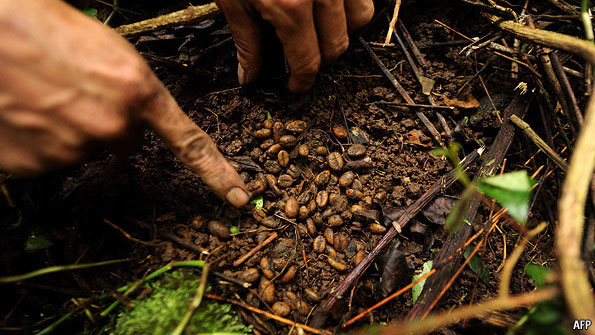
Coffee beans in civet scat. Image: http://www.economist.com/blogs/prospero/2012/01/coffee-vietnam
By Gladys Chua
According to The Economist, “Vietnam is the world’s second-largest coffee producer, but also one of the most obscure.” Until recently, little has been known to the wider public, about the use and abuse of civets in the production of one of the priciest coffee beans around the world.
The lure of ca phe chon – novelty and prestige
Self-proclaimed coffee enthusiasts, such as Mr Hung, co-founder of Legend Revived (a luxury brand in Ho Chi Minh City that exports coffee beans to Britain and Norway at a hefty sum of $500 per kilogram), insists on the supposedly more exquisite, fragrant and exotic origins of ca phe chon (Vietnamese for ‘civet-cat coffee’) in his line of business.
To businessmen, it seems that manufacturing coffee was only one aspect of the trade; sales and marketing of their brand of coffee was an integral part of increasing demand and market value of said products. It is then apparent that businessmen in the trade do not just sell coffee; they leverage on the existence of social ladders to market aspirations, acceptance and the acquisition of goods to raise one’s social standing. Presently, vendors are known to make a fortune flogging fake civet coffee to travellers and locals.
A university student in Ho Chi Minh City observes that the thirst for social acceptance and prestige overwrites the pursuit of authentic civet coffee, since the imitation is increasingly something locals settle for simply because it costs much less. The desire could be interpreted as a response to the lure of global marketing, and for acquiring items that are markers in an upwardly mobile society.
In the twentieth century, civet coffee became an increasingly popular bourgeois experience, due to the novelty and prestige associated with its purchase and consumption; The increased demand motivated more local farmers to produce ca phe chon on a larger scale, and the race to profit from the growing industry perpetuated the farming of civets at the expense of their welfare.
What it’s really like at a ca phe chon farm
By means of trapping or rearing, poached civets are kept in dingy cages that are far smaller than their home range in the wild. Mr. Yang Yi Yong verifies this, as he recalls his trip to Da Lat, Vietnam, in late October 2011, where he visited a coffee-producing facility. Unimpressed by the sight that greeted him, he explored the sides of the nondescript single-storey building, where he saw the miserable state of civets in captivity.
“[The cages] were not more than 1m by 0.5m by 0.5 m, [and] was made of strips of metal, with no bedding, food and water bowls, and cover,” he said.
“The civets mainly kept to themselves, either curled up in a corner, or pacing around their partitions.”
Mr. Yang is concerned about the welfare of the captive civets, which exhibited stereotypic behaviours, indicative of a lack of appropriate stimulation, stress and overall dissatisfaction. Passivity may also be associated with a lack of food variety. Often, these caged civets live in substandard conditions and are force-fed a monotonous diet of coffee beans.
He added, “There wasn’t any activity, such as feeding or collecting, while I was there.”
Interestingly, the origins of the captives remain unknown, even to the owner of the operation except the fact that the civets were reared for the production of “weasel coffee” (as kopi luwak is known in Vietnam). Further probing yielded no additional information about how the civets came into possession, the levels of fecundity, the facility’s production volume, or who their patrons are.
As of now, the ethical considerations of rearing civets in desolate conditions, for the mass production of weasel coffee, remain unseen. Welfare issues aside, large-scale ca phe chon production were also responsible for illegal deforestation all over Vietnam. Needless to say, habitat destruction implicates other wildlife, and forest fragmentation perpetuates the diminishing of provisioning ecosystems.
Ignorance is a choice
As end-consumers, we may leverage on the sheer purchasing power we possess in the network of market exchange relations, to make the sale of civet coffee obsolete. There are also many other ethical alternatives to civet coffee. Being discerning global citizens in the Information Age, ignorance is a choice.
Let your friends know how we can all help in turning the trade, and help us eliminate the sale of civet coffee in Singapore! Sign the pledge today: https://projectluwaksg.wordpress.com/support/
_________
References
Carr, G., 2012. The Economist. It’s the shit. http://www.economist.com/blogs/prospero/2012/01/coffee-vietnam
Haque, A., 2006. Distressed Animal Behaviors and Some Recommendations for Improvements at the Kuala Lumpur Zoo, Malaysia. Journal of Applied Animal Welfare Science, 9(4): 333-335.
Kumar, A., 2011. The Economist. Wholly shit. http://www.economist.com/blogs/babbage/2011/09/frugal-innovation
Pingback: Behind the scenes at a kopi luwak farm in Bali | Project LUWAK Singapore
Pingback: Ethical Civet-a Glimpse from the Mountaintop | apothecary's garden